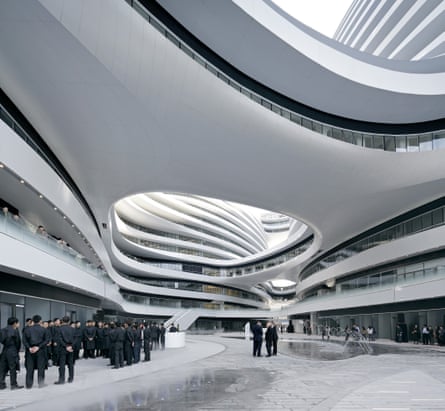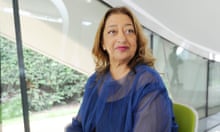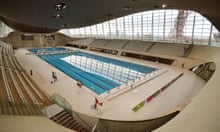Vitra fire station, Weil am Rhein (1994)
Hadid’s first completed project – a complex construction of tilted and clashing planes – looks very different from her later, organic designs. “A clear demonstration of the rhetorical power of architecture – and the possibility of achieving impressive effects with modest means,” said the Architectural Review, admiring the “gestural, pointy porch that yells ‘Emergency!’” Its daring geometries proved too much for the firemen, who moved out, leaving the building to become an events space.
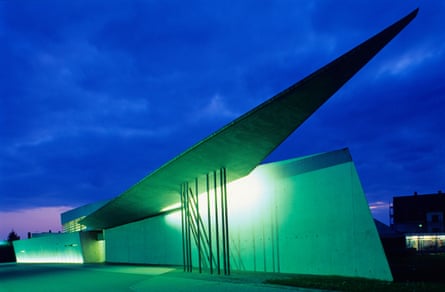
Phaeno science centre, Wolfsburg (2005)
The Phaeno science centre “condenses a lot of the things that have been in my work for a long, long time”, Hadid said, while a critic described it as “an astonishing, exhilarating concrete and steel vortex of a building – somewhere you go to experience the operatic power of space”. Raised on fat concrete cones, it is a cathedral of jagged angles, looming curves, fractured planes and daring protrusions, its 154 metre length seeming to hover in the air.

Photograph: Rainer Jensen/EPA
Bridge Pavilion, Zaragoza (2008)
Inspired by gladioli and the waterway beneath it, Hadid’s first completed bridge throws 280 metres of fibre-glass reinforced concrete across the river Ebro. Half pedestrian walkway, half exhibition area, the covered structure was built to link the La Almozara neighbourhood to the site of the 2008 Zaragoza Expo. “A magnificent and truly ennobling way to cross a river on foot,” was the Guardian’s verdict.

Evelyn Grace Academy, London (2008)
This £36m Z-shaped school in Brixton, south London – with a running track tunnelling right through it and out the other side – beat another hot favourite to win the Stirling Prize. Given that the hot favourite was the Olympic velodrome, this was the year when Hadid – whose office was a former school – finally felt she was being acknowledged in Britain.

Guangzhou opera house, Guangzhou (2010)
“Like pebbles in a stream smoothed by erosion,” was how Hadid herself described this £130m building, which was designed to blend in perfectly with its riverside setting. Regarded as one of the most alluring opera houses ever built, it boasted a folded, flowing glass structure that let light flood in. The creation was inaugurated with the first ever performance in China of Puccini’s Turandot, a controversial opera in the country. But the “erosion” was a little more severe than planned: a year after the building opened, cladding panels were already falling off.

Sheikh Zayed Bridge, Abu Dhabi (2010)
With its swooping arches and curves intended to emulate the rippling of sand dunes, this 842-metre bridge hangs on the horizon like a frozen scribble. Named after the country’s principal architect and former president, the £200m structure – spanning the Maqtah channel – is perhaps at its best at night, when coloured lighting floods its spine.
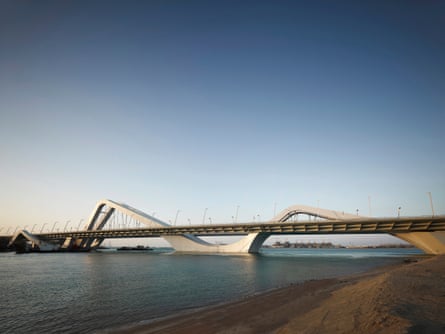
Riverside museum, Glasgow (2011)
Hadid’s first major building in Britain, dubbed “Glasgow’s Guggenheim” and winner of the 2013 European museum of the year award. Beneath a stunning zinc-clad zigzag roof, a 36m-high glazed frontage overlooks the river Clyde. The steel-framed structure, built on the site of an old shipyard, houses a column-free, 7,000 square metre exhibition space. Costing £74m, it has been criticised for its display strategy – in which many exhibits are placed high up on the wall too far from view.
London aquatics centre, Stratford (2012)
The “most jaw-dropping municipal swimming pool in the world”, according to the Guardian. Originally built for the 2012 Olympics at a cost of £269m, this cathedral-like space seats houses two 50-metre pools and seats for 2,500 spectators. Its wave of a roof rests on just three concrete supports, and huge windows let the light flood in.

Heydar Aliyev cultural center, Baku (2012)
All swooping curves and flowing space, this 619,000-square-foot complex in the capital of Azerbaijan won the London Design Museum award in 2014; one judge called it “as pure and sexy as Marilyn’s blown skirt”. The softly folded roof shelters a museum, an auditorium and a multi-purpose hall. Reports put the cost at $250m. Human rights groups have criticised the project for seeing families forcibly evicted from their homes on the site.
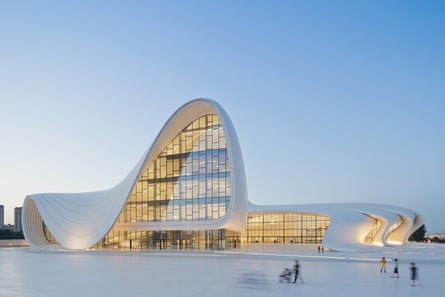
Galaxy Soho, Beijing (2012)
Possibly the most space-age-looking of all Hadid’s works, this spooling creation comprises four domed structures linked by a ravishing mixture of bridges and platforms flowing around what can only be called a central canyon. Like a smoothed off mille-feuille, the 18-storey retail, office and entertainment colossus boasts interior courts intended to reflect traditional Chinese architecture – although it has been criticised by local heritage groups for flattening an area of historic hutongs.
